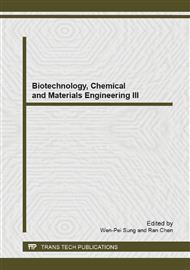p.104
p.108
p.112
p.117
p.121
p.125
p.129
p.134
p.140
Preparation of Two Magnetites and Application for the Removal of Fluoride from Waters
Abstract:
Two magnetites (M-20 and M-80) were successfully prepared by two different methods. The XRD patterns showed that M-20 was a poorly crystalline magnetite and M-80 possessed a relatively well crystallinity. For M-20 and M-80, the specific surface area (SSA) was 48.53 and 26.72 m2/g; at pH 5.0 the zeta potential was 28.34 and 23.51 mV; and the isoelectric point (IEP) was 6.8 and 7.0, respectively. At pH 5.0, the Langmuir adsorption capacity for fluoride of M-20 and M-80 was 12.45 and 9.89 mg/g, respectively. This indicates that M-20 is a higher efficient adsorbent for fluoride removal from waters compared to M-80. Langmuir model was suitable to fit the fluoride adsorption data of M-20 and M-80 (R2 =0.988 and 0.982, respectively) and Freundlich model can not well fit the fluoride adsorption data of the two magnetites (R2 =0.937 and 0.951, respectively).
Info:
Periodical:
Pages:
121-124
Citation:
Online since:
January 2014
Authors:
Keywords:
Price:
Сopyright:
© 2014 Trans Tech Publications Ltd. All Rights Reserved
Share:
Citation:


